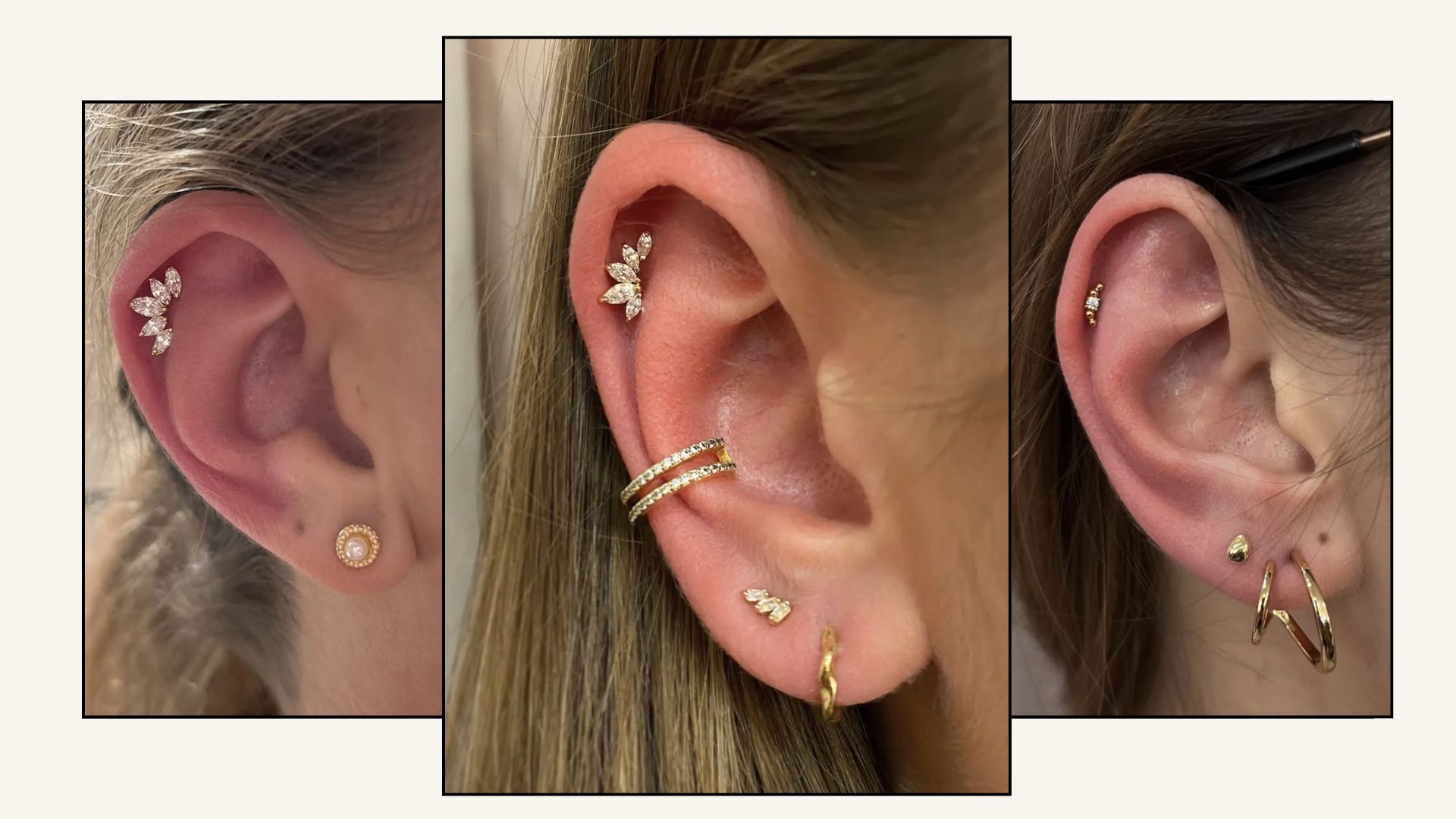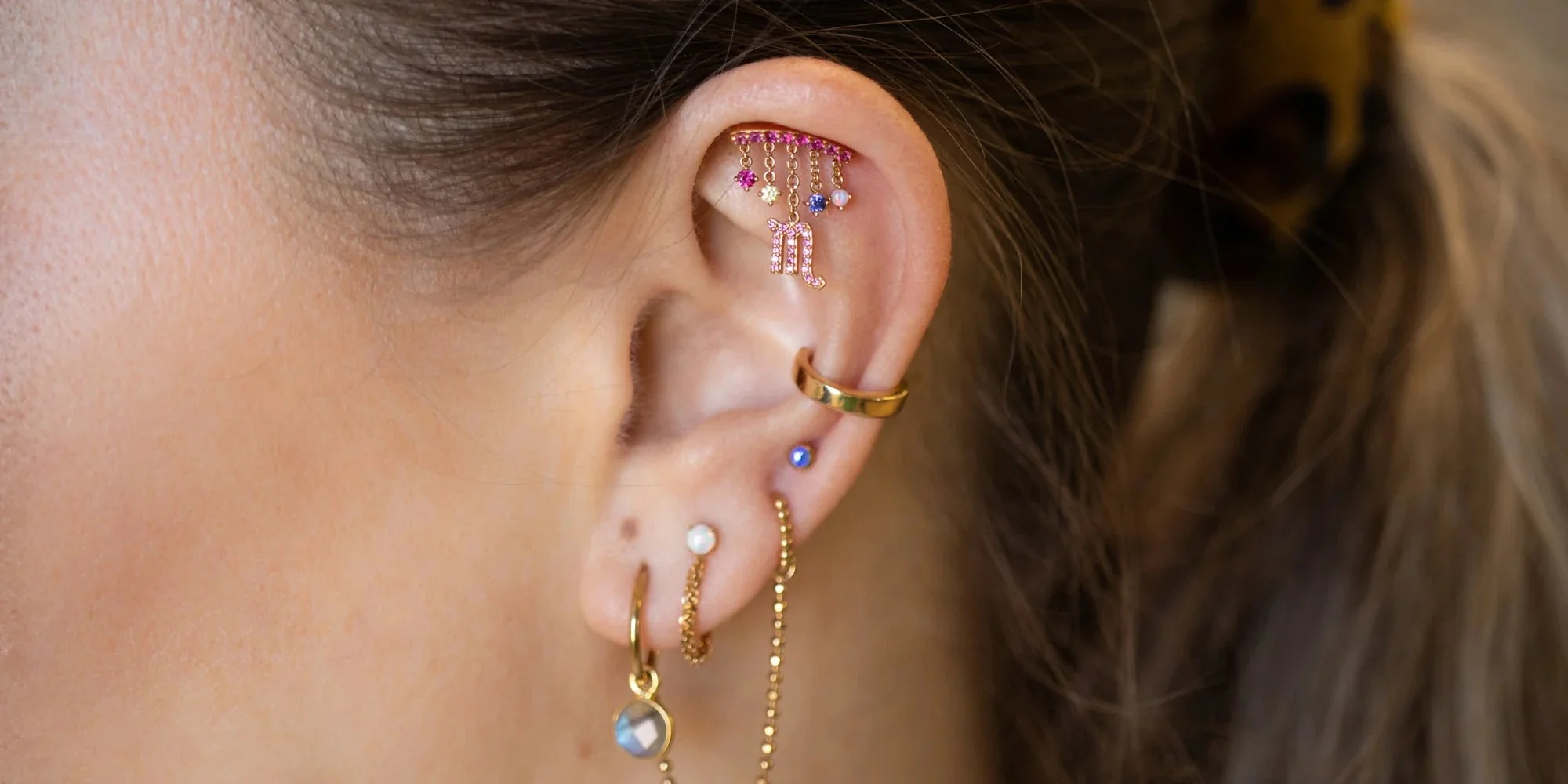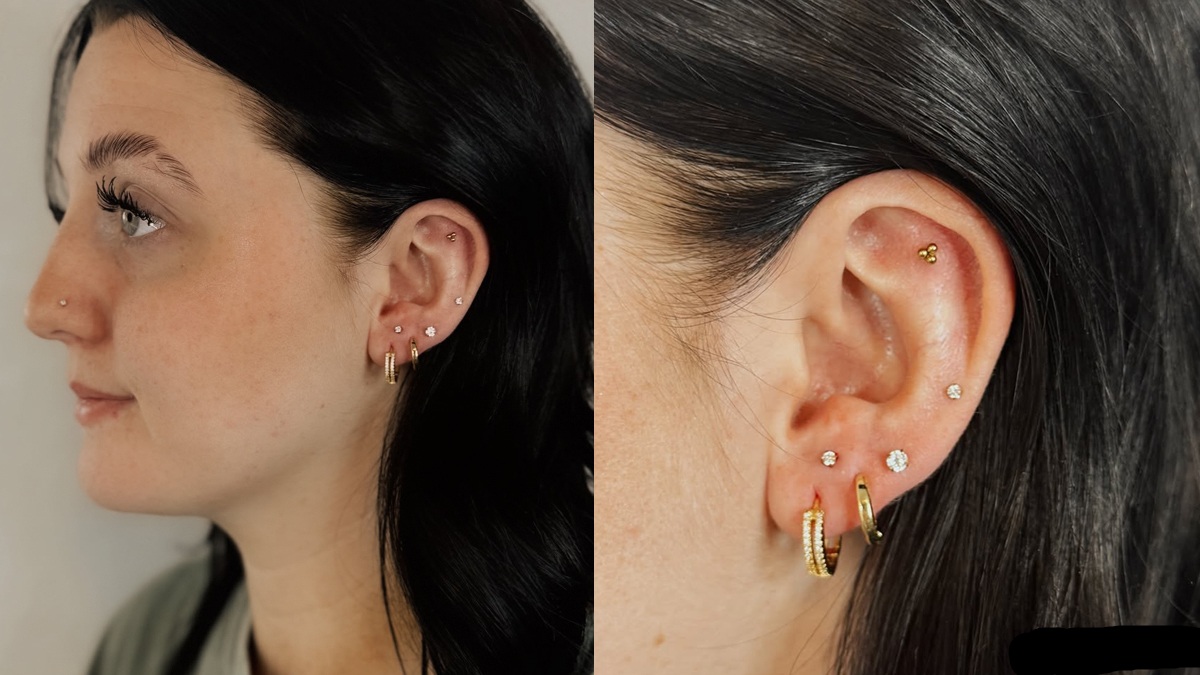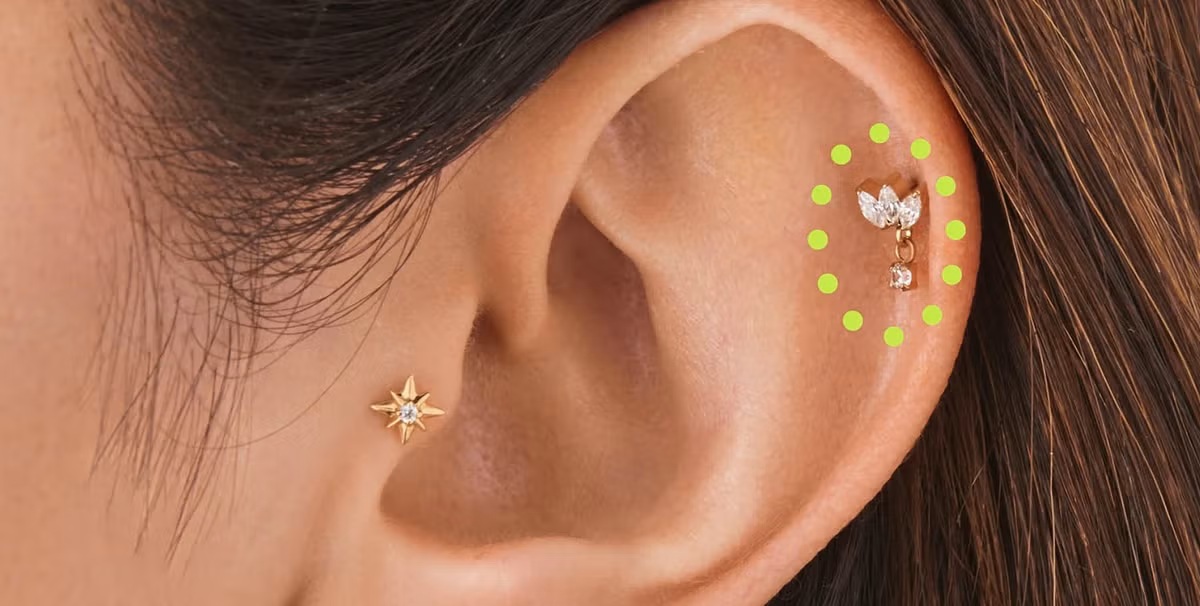In the world of ear curation, the classic helix piercing—a delicate hoop or a sparkling stud tracing the ear’s upper curve—is a beloved staple, a foundational element in countless style stories. But for the true style connoisseur, for the individual seeking something more architectural, more unexpected, and distinctly modern, the evolution of this classic has given rise to the vertical helix. Imagine a piercing that defies the ear’s natural contours, a sleek barbell that travels straight down through the curled edge of the helix itself, creating a visually arresting vertical line where a curve is expected. It is a sophisticated and edgy statement, a piece of minimalist architecture for the body, and it is rapidly emerging as a key look for London’s most discerning piercing enthusiasts as we head into late 2025.
However, the stark, clean beauty of a perfect vertical helix lies entirely in its precision. This is a piercing of angles, perspectives, and millimetre-perfect execution, one that demands a true specialist’s eye and an artist’s understanding of form. We recently had a wonderfully collaborative consultation with a design student named Leo, who came to our London studio with a clear desire for something unconventional. He loved the idea of a helix but was adamant about avoiding the “standard” look he saw everywhere. Our lead specialist, after listening to his ideas, introduced him to the concept of the vertical helix. The consultation quickly transformed into a design session. Using a sterile marker, we didn’t just tell Leo where it would go; we showed him. We demonstrated exactly how a clean vertical line, placed on his ear’s specific anatomy, would create a unique visual impact that complemented the strong, modern lines of his personal style. Seeing the design mapped out on his own ear, his eyes lit up. “It’s not just a piercing,” he said, “it’s like adding a piece of deliberate architecture to my ear.”
Leo’s story perfectly captures the essence of this piercing. It is for those who appreciate detail, design, and expert execution. This guide will serve as your definitive, in-depth resource for everything you need to know about the vertical helix piercing London, covering the intricate details of placement, the essential role of anatomy, the healing journey, and why a specialist’s hand is the only choice for a piercing of this complexity.

vertical helix piercin
What is a Vertical Helix Piercing? A Breakdown of the Technique and Philosophy
The vertical helix is often misunderstood. It is not simply a standard helix pierced at a strange or incorrect angle; it is a fundamentally different approach to piercing this part of the ear, with its own specific technique, jewellery, and aesthetic philosophy.
Vertical Helix vs. Standard Helix: The Critical Difference in Placement and Purpose
Understanding this distinction is key to appreciating the artistry involved. The difference lies in the direction of the piercing channel relative to the tissue itself.
- Standard Helix: This piercing is performed perpendicular to the tissue of the ear’s rim. The needle goes straight through from the front of the ear to the back. This orientation is what allows the piercing to perfectly accommodate a flat-back stud or, once fully healed, a hoop that elegantly hugs the natural curve of the ear. Its purpose is to follow and accentuate the ear’s existing lines.
- Vertical Helix: This piercing is performed parallel to the edge of the ear. The needle travels vertically through the curled-over ridge of the helix itself. It has a distinct top opening and a bottom opening, both located on the curled ridge. Its purpose is to create a new, deliberate line that contrasts with the ear’s natural curve, making a modernist statement.
The Ideal Anatomy: Do You Have the Right “Helix Curl” for It?
This is a crucial point we always emphasize with absolute transparency at PinkTatPier: the vertical helix is highly anatomy-dependent. This is not a piercing that is suitable or safe for every ear. To be a successful candidate, you must have a well-defined, prominent, and sufficiently “curled” helix ridge. This curl is essential as it needs to provide enough stable tissue for a viable piercing channel to be created.
If the edge of your helix is very flat, thin, or not pronounced, a vertical helix cannot be performed safely. Attempting to do so would result in a piercing that is too shallow, with a high likelihood of migration (the piercing slowly moving from its original placement) and eventual rejection by the body. A core part of our professional piercing service is an honest and thorough anatomical assessment. If your anatomy isn’t suitable, our specialists will explain exactly why and will be excited to suggest other stunning alternatives—like a forward helix or a conch—that will work beautifully and safely with your unique ear shape. Our “anatomy-first” approach is the cornerstone of our reputation.

vertical helix piercin
Jewellery for the Vertical Helix: The Barbell is Key
Due to its unique, straight channel through a three-dimensional, curved piece of tissue, the only jewellery suitable for a vertical helix is a barbell. Depending on the specific thickness and curvature of your helix, our specialists will select either a straight barbell or, more commonly, a slightly curved barbell. A slightly curved bar often sits more comfortably within the channel, reducing pressure on the healing tissue.
The initial jewellery will always be made from implant-grade titanium to ensure biocompatibility and will be slightly longer than the final piece. This extra length is critical to accommodate for the initial, and often significant, swelling phase without compressing the tissue.
The Art of Placement: Why a Specialist is Non-Negotiable
A perfect vertical helix is an optical illusion. It’s a straight line imposed on a curved surface. Achieving this effect requires an artist’s eye, a deep understanding of perspective, and a surgeon’s precision, which is why you must seek out London’s best specialists for this procedure.
Creating the Illusion: The Piercer’s Eye for Three-Dimensional Design
The piercer’s job is to create what appears to be a perfectly vertical line from a direct viewing perspective. This is incredibly challenging because they are piercing through a complex, three-dimensional, curved surface at a very specific angle. If the angle is off by just a few degrees, the piercing will look slanted and awkward from the front. If the placement is too far forward or too far back on the curl of the helix, it can affect not only the aesthetic but also the long-term health and healing of the piercing. This is a procedure that truly showcases the years of training and the innate skill of your piercer.
The PinkTatPier Consultation: Mapping Your Perfect Line
Our process is built on collaboration and transparency. It always begins with a detailed, unhurried consultation.
- Anatomical Deep Dive: We will begin by assessing your helix ridge, not just visually but by feel, to find the “sweet spot” that has the best and most stable tissue structure.
- Collaborative Vision: We will discuss your vision, look at your inspiration, and talk about how this piercing will fit into your potential long-term ear curation goals.
- Precision Mapping: Using a sterile, single-use surgical marker, we will meticulously mark the proposed entry and exit points. This is the most interactive part of the design phase. We will provide you with a mirror and show you the marking from multiple angles—front, side, and back. We encourage you to be critical and provide feedback, ensuring you are 100% happy with the balance, angle, and aesthetic of the placement before we proceed. This collaborative design process ensures the final result is exactly what you envisioned.

vertical helix piercin
The Healing Journey & Aftercare: A Commitment to Patience
The helix is cartilage, and all cartilage piercings require a significant healing commitment and a great deal of patience. A vertical helix, due to its placement on the outermost, exposed edge of the ear, can be particularly prone to snags and irritation during healing. Diligent, consistent aftercare is not just recommended; it’s absolutely essential for a successful outcome.
A Realistic Healing Timeline for a Vertical Helix
Healing is a journey with distinct phases. The table below provides a realistic timeline and key milestones for healing your new vertical helix piercing London.
Table: The Vertical Helix Healing Timeline & Key Milestones
| Timescale | What to Expect | Key Aftercare Actions |
| Week 1-4 | Swelling, redness, and tenderness are expected. The area can be quite sensitive to any touch or pressure. You may experience some minor bleeding or bruising. | Clean twice daily with sterile saline solution ONLY. STRICTLY AVOID sleeping on the piercing. Keep hair tied back and away from the area at all times. |
| Month 2-6 | The initial, dramatic swelling will subside, but the piercing is still very fragile and highly prone to irritation from accidental bumps or snags. | Continue cleaning as needed. Be incredibly mindful of glasses, hats, over-ear headphones, and especially snagging it while washing or brushing your hair. This is the riskiest period for developing irritation bumps. |
| Month 6-9 | The piercing will begin to feel much more stable and will be far less prone to random flare-ups. The fistula (the internal tissue channel) is strengthening. | This is the crucial time to book your downsizing appointment at PinkTatPier. We will replace the initial long bar with a shorter, snugger barbell to prevent future issues. |
| Month 9-12+ | The piercing is potentially fully healed. This means the internal tissue channel is strong, robust, and can handle jewellery changes. | Do not attempt to change the jewellery for purely decorative purposes until one of our specialists has professionally examined the piercing and confirmed that it is fully healed and mature. |
The Importance of Downsizing: The Most Crucial, Overlooked Step
We cannot stress this enough: coming back to our studio to have your initial longer bar swapped for a shorter one is a critical, non-negotiable step in the healing process. The initial bar is long to accommodate swelling. Once that swelling is gone, the excess length becomes a liability. It can snag easily on hair and clothing, causing repeated trauma that can lead to irritation bumps, migration, and even a permanent change in the piercing’s angle. The downsizing appointment is a key part of our comprehensive service and our commitment to your long-term piercing health.
Booking Your Appointment with London’s Best Specialists
At PinkTatPier, we have streamlined the process of starting your piercing journey to be as simple, transparent, and professional as possible.
Easy Online Reservation
We value your time and convenience. Our easy online reservation system is available 24/7 on our website. You can view our specialists’ schedules in real-time and book your appointment at your convenience, without the need for back-and-forth phone calls. This is the quickest and most efficient way to secure your slot for a vertical helix piercing London.
What to Expect from Pricing
The vertical helix is considered an advanced piercing due to the high level of precision, anatomical knowledge, and artistic skill required to perform it correctly. Our pricing reflects this specialist service and always includes the highest quality, implant-grade titanium initial jewellery. Please visit our dedicated pricing page for detailed, transparent information on all our services.

vertical helix piercin
Frequently Asked Questions (FAQ)
1. Is a vertical helix more painful than a regular helix piercing?
Pain is highly subjective, but most clients report the sensation as being very similar to a standard helix piercing—a quick, sharp pinch that is over in a moment. The primary difference is not in the initial pain, but in the healing journey. The vertical placement can be more exposed and requires extra care and diligence to avoid snags and irritation.
2. How do I stop my glasses from irritating a new vertical helix?
This is an excellent and practical question. During your initial consultation, we will ask you to put on your glasses so we can assess where the arms naturally sit. We can often adjust the placement of the piercing to sit comfortably above or below the arms of your glasses. However, if you wear thick-framed glasses that cover a large area, you may need to be extra cautious or consider wearing contacts more often during the initial, most sensitive healing phase.
3. Can I ever wear a hoop in a vertical helix piercing?
Generally, no. The piercing channel is a straight line through the tissue. A hoop is circular and would put immense, constant pressure on the channel, which would almost certainly lead to severe irritation, tissue damage, and potential rejection. The vertical helix is a piercing that is designed exclusively to be worn with a straight or slightly curved barbell to showcase its unique and beautiful vertical aesthetic.
Conclusion: A Modern Statement of Precision and Intent
The vertical helix piercing is a sophisticated, architectural choice for the discerning piercing enthusiast. It is a piercing that speaks of an appreciation for detail and modern design. It takes a classic placement and gives it a minimalist, high-fashion twist. Its success is a perfect marriage of your unique anatomy and the precision artistry of a specialist piercer. At PinkTatPier, we possess the expertise, the experience, and the passion to execute this beautiful piercing with the world-class safety and accuracy it demands.
Your Next Step: Easy Online Reservation
Are you ready to elevate your ear curation with this uniquely modern and architectural piercing?
Our easy online reservation system is the simplest and fastest way to begin your journey. Book your appointment with London’s best specialists at PinkTatPier today, and let us help you create a stunning, perfectly placed work of art that is uniquely you.

